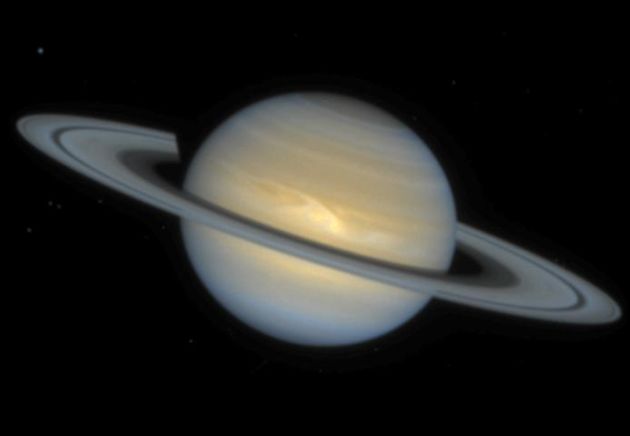Inside the Giants: Puzzling Differences in Jupiter and Saturn

Scientists aren't sure what the interiors of Jupiter and Saturn look like or how the planets formed. But a new study of their insides suggests they took different paths to giant status.
Researchers modeled 50,000 what-ifs of internal structure using real data from the two planets and lab experiments that show how material behaves under extreme pressure. They found Saturn has a huge core and Jupiter may have none.
"Heavy elements are concentrated in Saturn's massive core, while those same elements are mixed throughout Jupiter, with very little or no central core at all," said Didier Saumon of the Los Alamos National Laboratory.
The result, published last week in the Astrophysical Journal, agrees with similar studies but is far more comprehensive. "These conclusions are now very firm," Saumon said in a telephone interview.
Why so different?
Both planets are about 70 percent hydrogen. Most of the rest of their makeup is helium. The remaining "heavy elements" include iron, silicon, carbon, nitrogen and oxygen.
But why would only Saturn end up with a heavy core? The question is a troubling one for planet-formation theorists.
Breaking space news, the latest updates on rocket launches, skywatching events and more!
The leading model for giant planet formation involves first growing a core of rock and ice several times the mass of Earth. Once big enough, this core easily attracts and holds onto gas, sweeping through the nascent solar system and glomming on to hydrogen and other elements left behind in the Sun's formation.
But this so-called core-accretion model has a problem. It takes millions of years to build a gas giant, and observations of other star systems suggests the gas swirling around a newborn star doesn't hang around that long.
An alternative theory has a gas giant collapsing out of a knot of gas. This method can form the seed of a Jupiter-like planet in just 1,000 years or so. But the theory hasn't allowed full modeling of a finished planet so far, Saumon said, and only a handful of researchers embrace it.
As Saumon points out, if Jupiter has little or no core, it would seem to lend credence to the gravitational collapse idea. He's not ready to give up on the standard model of core accretion, however, in part because scientists prefer common solutions to explain similar-looking, neighboring objects.
"We don't really believe the two planets would have formed by two processes so different," he said.
Crushing pressure
Saumon speculates on what might have happened with Jupiter: The king of the nine planets contains 318 times more mass than Earth (Saturn contains about 95 Earth masses). Jupiter's core would have been melted to liquid under intense pressure during formation.
"If it accreted gas very, very fast, this large amount of mass would come crashing down fast enough to induce mixing of the core," he said. The sort of heavy elements which, in the center of Saturn form a core, were instead mushed around and spread throughout Jupiter.
He cautions that more observations are needed to settle the case.
"You can't see the core," Saumon said. "The measurements we have are very indirect." Rapid rotation the giants -- each spins around once about every 10 Earth-hours -- causes them to bulge at their midsections in a way that depends on internal structure, and space probes have measured the bulges in the gravity fields of the planets during flybys. "It's a very indirect way of determining the internal structure. But that's all we have."
Gravity measurements of Saturn by the Cassini spacecraft, especially if it is allowed to operate beyond the four years of the planned primary mission, could improve understanding of its deep mysteries, Saumon said.
- Alien Worlds through Artists' Eyes
- Cassini Mission: Complete Coverage

Rob has been producing internet content since the mid-1990s. He was a writer, editor and Director of Site Operations at Space.com starting in 1999. He served as Managing Editor of LiveScience since its launch in 2004. He then oversaw news operations for the Space.com's then-parent company TechMediaNetwork's growing suite of technology, science and business news sites. Prior to joining the company, Rob was an editor at The Star-Ledger in New Jersey. He has a journalism degree from Humboldt State University in California, is an author and also writes for Medium.
